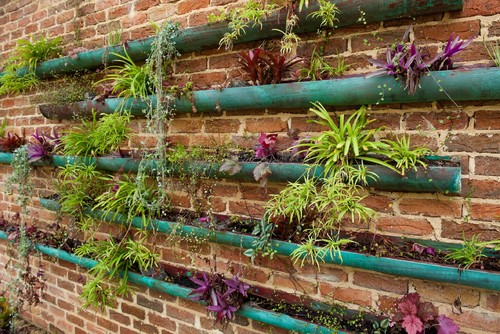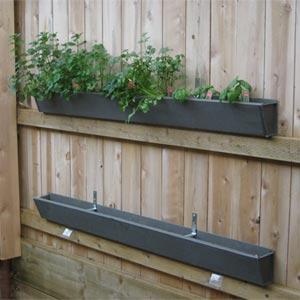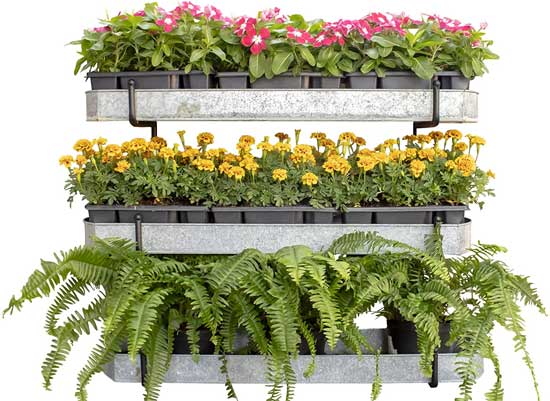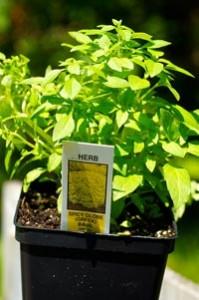How To Build A Vertical Garden With Guttering
The first time I saw a picture of a gutter garden, I was hooked and had to have one for myself. It was so neat and organized-looking. Plus, it shouted "Low Maintenance!", which is right up my alley.

Gutter Gardens & How to Make Your Own
 The picture on the left shows the gutter garden I built, but there are lots of different styles and materials you can use. Some people make hanging gutter gardens that are not attached to a wall.
The picture on the left shows the gutter garden I built, but there are lots of different styles and materials you can use. Some people make hanging gutter gardens that are not attached to a wall.
I've seen others that run back and forth diagonally to create an easy watering system. Of course some people also have plants growing out of their rain gutters that have gotten clogged with debris (ok, that's a joke).
There are so many benefits to gutter gardens – but even if you don't care about those, they're cool to have anyway.
1. They are Cheap and Easy to Make
You can pick up basic materials at your local home improvement store very inexpensively. If you can glue, drill and put dirt in a container, this job is calling your name.
Alternatively, you can buy pre-made gutter style planters. Therefore, you don't have to build one yourself.

2. You Don't Need a Large Yard
Gutter gardens are vertical, so they take up virtually no floor space. This means you can live in a very urban area and grow as many plants as your wall space can accommodate.
3. They Keep Plants Safe from Lots of Pests
If you're worried about gopher, raccoons, dogs or other plant predators attacking your plants, fear no more! Gutter gardens high off the ground can keep your plants alive and happy.
4. You'll Suddenly Have Lots of Friends
Once people see your awesome gutter gardens, they will be amazed, ask you where you got them, then find out you made them yourself and then think you're super cool. Well, maybe.
If you are looking for a more industrial look or simple design, a gutter garden may be just your style. You can plant a bunch of different plants or herbs in a single gutter, and watering and drainage can be extremely easy if you hang your gutters at a slight angle.
I've seen gutter gardens that are 12 feet long that extend alongside of a house. You can also cut gutters to a shorter length and "stack" them one above the other, letting the top drain into the gutters below it.
A nice benefit to growing plants in gutters is that you can place them high enough where pets and other critters can't get to them. This is especially important if you are growing edibles.
Materials Need to Build a Gutter Garden Planter:
All you need to do is go to your local home improvement store and get yourself some rain gutter with end caps and supports. You can attach these to a wall or a fence or build a frame (see video below) to attach the gutters together and then hang them.
Materials are very inexpensive, plastic being cheaper than steel. They are also both very durable so they will last you a long time.
Tip: Something to keep in mind when planting in a warm, sunny location is the color of your gutter. Darker gutters will heat up the soil more and may dry out plants faster than a bright white gutter that will reflect light and heat. Since gutters can't hold as much dirt as a typical pot, this can can have a bigger impact on your plants.
Note:I actually used steel gutters in the photo above, since I liked the industrial look – and the location is mostly shaded so heat wasn't an issue.
What to Plant in a Garden:
As I mentioned about, gutters don't provide lots of space for soil, so it's best to grow smaller-sized plants or ones that don't need a lot of space for their roots. This can also help with the weight of the structure if you plan to hang it on a fence where you may be concerned with weighing it down too much.
Herbs are awesome for this reason, but lettuces are also popular. Annuals could work quite well, especially if you are creating a gutter garden as a work of art in your backyard.
 I didn't want my gutter garden to stress my fence out. The gutters and other material are light, but the dirt combined with water can get heavy. Therefore, I did a few things to keep the garden as light as possible:
I didn't want my gutter garden to stress my fence out. The gutters and other material are light, but the dirt combined with water can get heavy. Therefore, I did a few things to keep the garden as light as possible:
1. I planted smaller herbs because they don't grow big, and they need less dirt.
2. I used a narrower taller gutter instead of a wider gutter that would likely need more dirt to cover the plants' roots.
3. Using an existing support beam (or adding one of your own) can help distribute the weight of the garden more evenly.
Some Things I Learned from Building a Gutter Planter:
Since gutters can hold many different plants together, it's important to avoid using fast and spreading growers, like mint (no offense, Mint!), that will overtake your other plants. That is, of course, unless the entire gutter is mint.
Instead of having water simply drip out of the base of the planter, I glued a 3/4 drip line to the base and directed the extra water to a nearby planter holding another plant. No wasted water and no messy dripping. Gorilla Glue worked for me, although you may need to re-glue it occasionally if the tube gets jostled frequently.
Making an Herb Gutter Garden…
growing herbs in gutter gardens care great because they are generally smaller and lightweight. My garden contains spearmint, orange mint, lemon balm, parsley, cilantro and basil. Here is a list of other herbs that you can usually find at your local nursery or garden center. You can also start your garden from seeds.
– Thyme
– Oregano
– Chives
– Stevia
– Marjoram
– Sage
– Tarragon
– Rosemary and Lavender (although these can get big if not trimmed regularly)
How To Build A Vertical Garden With Guttering
Source: https://easyverticalgardening.com/building-a-vertical-gutter-garden/
Posted by: fieldsbaccerst.blogspot.com

0 Response to "How To Build A Vertical Garden With Guttering"
Post a Comment